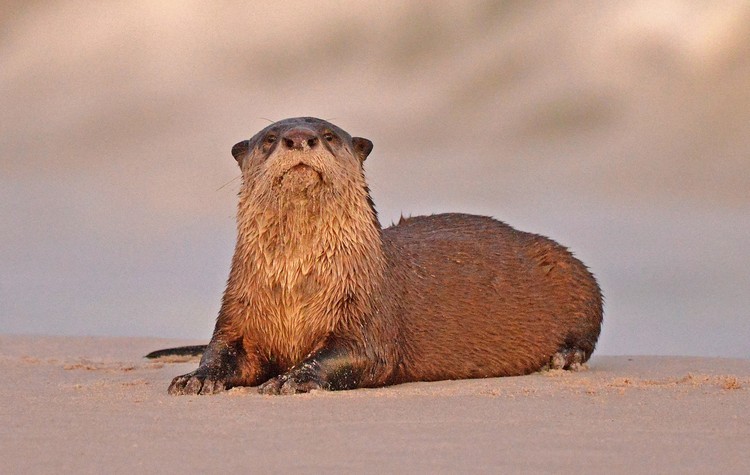
24 October 2024
A Cape clawless otter on Long Beach, Kommetjie, one of many indigenous species in the Noordhoek wetlands section of the Table Mountain National Park. Photos: John Yeld
The vision of a fully consolidated and ecologically integrated Table Mountain National Park stretching the entire length of the Cape Peninsula has been boosted with the donation of a key “missing link” corridor element at Kommetjie.
This week, two adjoining properties totalling 25.5 hectares, which form the final link in the undeveloped Kommetjie-Noordhoek wetlands land chain joining the central and southern sections of the Park, were formally handed over to SANParks at a ceremony at the historic Imhoff’s Gift farm.
The 4.7ha and 20.8ha properties were donated respectively by companies Kommetjie Estates and Red Cliff Property, major landowners in the area, and have been owned by the extended Van der Horst family since 1902.
SANParks called the donation “a significant milestone for conservation” that would “enhance biodiversity and strengthen the park’s ecological integrity”, and it was welcomed by speakers at Tuesday’s hand-over ceremony.
But the donation also has its critics, who argue that the corridor has been used as a bargaining chip to get approval for major developments on land on either side of it that is also of very high conservation value and is now lost.
After the Table Mountain National Park was proclaimed in 1998, one of the immediate priorities was to connect the central and southern sections of the new park by creating a functional ecological link between Chapman’s Peak (Noordhoek) and Slangkop (Kommetjie) across the so-called “Noordhoek–Fish Hoek gap”.
The only available option was to acquire the extensive undeveloped Noordhoek-Kommetjie wetlands that were also owned by the Van der Horst family.
The Kommetjie Corridor and Wetlands Land Acquisition Project was duly initiated with strong support from the Table Mountain Fund (TMF), WWF-SA and the City of Cape Town.
The project team raised R24-million from a variety of sources, including R2.5million from the TMF, and in 2004 acquired 440ha of the wetlands property in a R24-million deal.
Greater Flamingos, gulls and terns in the vlei at the southern end of the Noordhoek wetlands section of the Table Mountain National Park.
The wetlands contain patches of unspoilt Sandplain Fynbos, dune thicket, dune pioneer plants, mobile dune fields, coastal zone wetlands, and seasonal and permanent wetlands, and the area is one of 39 core botanical sites within the boundaries of Cape Town.
The CAPE Project, a partnership programme between government and civil society organisations formed around a 20-year vision for conserving and restoring the biodiversity of the Cape Floristic Region, identified the wetlands remnants as “irreplaceable”.
But there was still the one “missing link” in this conservation mosaic: a narrow strip of land at Kommetjie, lying between Imhoff Farm on the northern side and the approved housing developments of Protea Ridge and Riverside Village on the southern side.
Negotiations and discussions, described variously as “intensive” and “robust”, continued over years before reaching the agreement that was formalised with signatures at the hand-over ceremony.
Table Mountain National Park manager Megan Taplin described the donation of the 25,5ha corridor as “a huge achievement”.
“Not only for its conservation worthiness and landscape connectivity, but because of the price of, and demand for, land in and around this protected area surrounded by a city.
“The fact that the landowners involved had the foresight and will to dedicate this land to conservation in perpetuity is of great value for all of us and for future generations. Let us all commit to playing our part in ensuring that it’s well managed and protected, to fulfil the vital function which it serves,” she said.
SANParks regional general manager Bongani Mnisi pointed out that Table Mountain National Park was the most visited of all protected areas in South Africa’s suite of national parks and was second only to the Waterfront in terms of tourism visitor numbers.
“The only way we can continue to protect biodiversity in the Park is by working together to protect it,” he stressed.
Patrick Dowling, chairperson of the Kommetjie Residents and Ratepayers Association, said he’d had doubts that the corridor could be achieved – “I’m really impressed – I didn’t think it would come to this.”
He pointed out that the donation had come at a time of exceptional biodiversity loss in the world – “We have today added a few important pixels to the global portrait of biodiversity.”
But Dowling also cautioned that “the devil will be in the detail” and that future management to restore and maintain the property would need to include alien invasive plant clearing, curbing poaching and preventing “other human wrong-doing”.
Kommetjie conservationist and environmental writer Adam Welz is one of those who has serious concerns about the creation of the corridor in its present form.
He says it has come at a cost of significant tracts of “super-biodiverse fynbos” in the Kommetjie area that are the habitats of many threatened plant species as well as animals like the Cape Grysbok and Caracal Lynx. This is because the promise of the corridor has been used as a bargaining chip to get development rights over adjacent land of equally high conservation value, and many hectares of irreplaceable natural habitat will now be bulldozed for the Imhoff Manor and Protea Ridge urban estates adjoining the corridor, he says.
“It’s heart-breaking to watch these beautiful places filled with rare species, that are a global heritage, being destroyed,” he says.
Terns take to the air above the vlei at the southern end of the Noordhoek wetlands section of the Table Mountain National Park, with gulls in the foreground.